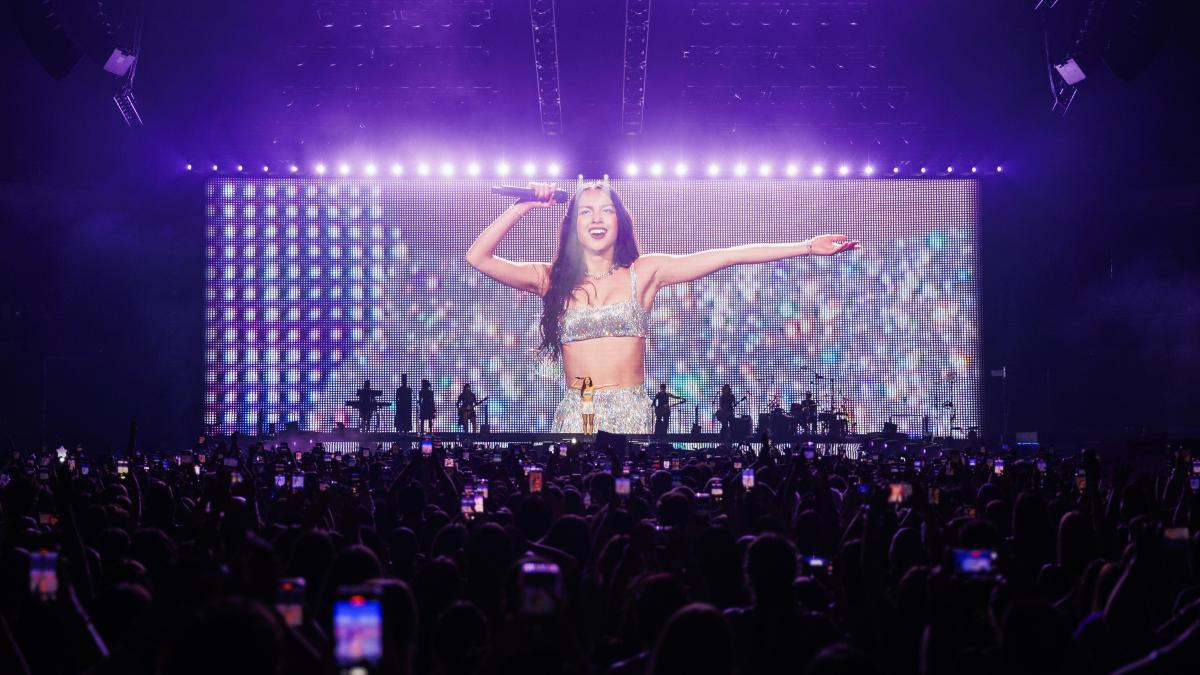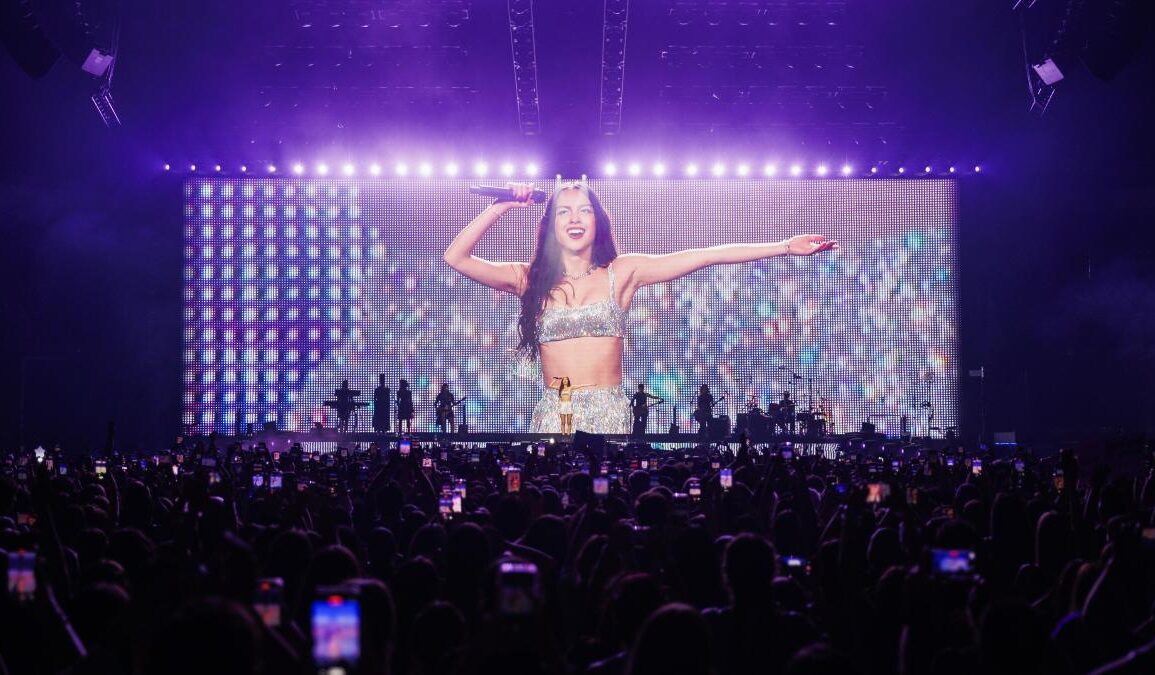
American singer Olivia Rodrigo, perched on a crescent moon-shaped structure, hovers above the audience. An overwhelming majority of the crowd energetically raise their phones to record the artist as closely as possible. Sixteen-year-old Silvia nervously asks her friend, “Did you record her? Did you capture the moment she waved at us?” Her friend reassures her not to worry, as she has the video. After the concert ends, Silvia mentions that she has taken many videos because she wants to share them on Instagram and TikTok, but she also confesses that she doesn’t want to forget the experience of attending the concert.
Recently, starting from Taylor Swift’s concerts in Europe, the media has echoed a phenomenon that leaves fans who attend her concerts stunned. Specialists of psychology claim that it occurs with any situation that causes extreme heightened emotion. It’s called post-concert amnesia. Not only that, but the videos taken by fans at Swift’s concerts and uploaded to social media, especially TikTok, add up to more than 2 million, according to data from the platform itself. Many of these clips are streamed live from the event via mobile phones thanks to features like Instagram Live, which offer the possibility for our friends and followers on social media to “experience” the concert in real time, almost in the same way as someone who has bought a (often expensive) ticket.
We are so overstimulated that it is easy to quickly forget the sensations and emotions that have been experienced in a specific experience”
“The need to document and preserve memories has always existed, but now it is more accessible than ever. The human memory has gaps, and having videos can help us evoke memories,” explains psychologist Eva Molero to La Vanguardia. She adds that recording videos and constantly taking photographs of any social situation experienced may be related to a need to share experiences “or to seek and find social validation.”
According to the latest data count from Meta in 2022, 500 million users use the “stories” feature on Instagram: a photo or video is uploaded and any user with access to that profile can view it for a period of 24 hours. After that, the content disappears. Its use began specifically to share in real time what the user was experiencing. “Technology has brought us many good things, but like everything, the problem is not the social networks themselves but how we use them, the importance we give them, and the role they can come to play in our lives,” reflects Molero.
Silvia, during Olivia Rodrigo’s concert, comments that one of the aspects that concerns her, and that is why she feels confused about recording her favorite songs or not, is because she is afraid of not being able to “enjoy the moment” and being too focused on recording. Psychologist Molero explains that the need to want to have experiences recorded to be able to remember them does not prevent being present. However, she clarifies that if mood, self-esteem, and emotions depend on being able to have it recorded or photographed, “it will indeed be more difficult to enjoy and appreciate them.”
When I have to record something and I am with my friends, I record it and forget about it. Later on, I will process how to turn it into content”
However, she acknowledges that the use of technology is different from what it used to be, and that has consequences: “Now we are so super stimulated that it is easy to quickly forget things, or the sensations and emotions that have been experienced in a specific experience,” the psychologist states. Social networks have taken on the intermediary role between the experience and the exposure of the experience: “They are our most direct influences today; you would be surprised (or terrified) to see the time we dedicate to them,” she reflects.
There are already professionals dedicated to recording content to upload on social media, whether to promote their own image or a brand. Carla Huste is a model and content creator at USC. She acknowledges that when she started in the world of social media, she was aware that she needed to strike a balance between living in the moment and recording it to have content. “I have turned what used to be my hobby and what I consumed in my free time into my job,” declares Huste. She engages in self-awareness when using social media, pausing to think “am I working, or am I resting?”
Huste suggests that the best way to balance creating content with life is to record moments, take photographs, and not share them on social media. “When I have to record something and I’m with my friends, I record it and forget about it. Later, during my working hours, I will process how to turn it into content and how to take advantage of it,” explains the model. She is also cautious about which moments to share and when to do so. “There’s something someone told me once that I think about a lot: ‘if you don’t post it, it doesn’t exist,’” comments Huste. She advises sharing on social media “what you want people to know and keep the rest for yourself.” She explains that despite having few followers, the content posted on social media ends up being owned by the companies. And since it is public, it is subject to external comments. “You have the power to share it or not,” concludes Huste.
In the end, as psychologist Eva Molero explains, social networks become a “showcase” of other people’s lives. And, as in stores, “in the showcase they usually put the most beautiful and striking things”, which sometimes leads us to crave that “perfect” life of others. Molero also comments that, recently, the capacity for amazement when traveling has vanished due to the constant exposure through videos and images on social media of places not visited. Seeing them portrayed on small screens, “probably my expectations of living experiences will be so high that I will never achieve them,” clarifies the psychologist on the matter.
But recording what we experience is not something that should be seen as negative, as “it allows us to share experiences with our loved ones, communicate, get closer, use it to express something, to tell someone we care about something important, without using words,” Molero explains. And yet, like any technological tool, it must have a specific purpose. The psychologist recommends that if the need to have everything documented graphically generates frustration, discomfort, or unease rather than well-being, it is necessary to “reassess the role and function that all of that plays.” She also encourages introspection through questions like “how do I feel if I don’t take photos and post what I’m experiencing?”, “what happens if the photo I take isn’t perfect?”, “do I enjoy less if I experience something and don’t share it?”, in order to determine one’s own experience with these devices.
This post was originally published on this site be sure to check out more of their content








